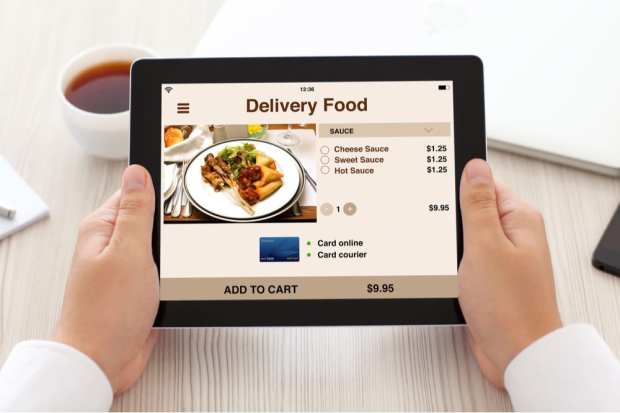Why QSRs Are Growing Digital Investments With Mobile, Partnerships

As consumers can have their favorite foods delivered to them with a tap of an app, quick-service restaurants (QSRs) are taking note of mobile ordering’s potential. Diners, as it stands, spend more via online channels or mobile than when buying in person, which makes delivery rewarding for restaurants and moves them to encourage ordering through those channels.
Wendy’s, according to the PYMNTS Order To Eat Tracker, has dedicated millions toward its digital investments, and those efforts have led to a 20 percent rise in average mobile order check sizes. And Wingstop has also worked to grow the availability of its mobile ordering service to offer the options at 90 percent of physical locations by the close of 2019.
From McDonald’s to Starbucks, quick-service innovators are expanding their mobile ordering efforts with the inclusion of delivery. These are just some of the ways that these companies, among others, are allowing consumers to order their favorite menu items from burgers to coffee with the help of mobile technology:
The number of McDonald’s restaurants offering delivery is 23,000. And the company is growing its delivery efforts. In September, McDonald’s and Grubhub announced a new partnership to begin expanding McDelivery to roughly 500 restaurants in the New York City and tri-state area. McDelivery was to be available both on Seamless and on Grubhub. Marcos Quesada, vice president of McDonald’s Stamford Field Office, said in a release at the time, “At McDonald’s, we’re constantly innovating to find new ways to best serve our customers whenever and wherever they want, whether it’s dining in our newly modernized restaurants, on-the-go through mobile order and pay or our drive-thru, or McDelivery. The convenience of McDelivery has been available to our customers in the NYC and Tri-State area for the past two years.”
Wendy’s is looking to bring sales from digital orders up to 10 percent by 2024. As it stands, digital sales are said to comprise only 2 percent of orders as of now for the QSR chain. Laura Titas, the chain’s chief digital experience officer, pointed out per reports that check sizes are 20 percent larger now with mobile orders. And the company experiences check sizes that are 50 to 60 percent larger with delivery in particular. In another case, Shake Shack entered into an integrated partnership with Grubhub to make its food more accessible to consumers via an increasing number of channels per news in August. Shake Shack CEO Randy Garutti said in an August announcement, “Shake Shack is experiencing incredible growth. Now more than ever, we’re doubling down on our commitment to be an accessible, omnichannel business.”
The share of KFC orders made via drive-thru lanes is 65 percent. KFC, for its part, will look into new drive-thru technologies such as menu boards that are powered by artificial intelligence (AI) in its digital strategy for next year. Innovations that can enhance order accuracy and upsell menu items are particularly attractive, as nearly two-thirds of the company’s sales are made at the drive-thru. The brand also rolled out a new platform for online ordering that is said to have come out ahead of expectations. In separate news from earlier in the year, AI-powered personalization platform operator Dynamic Yield announced it is being acquired by fast-food chain McDonald’s. The QSR chain will reportedly use the technology in its outdoor digital drive-thru menu displays as well as other customer touchpoints with the inclusion of the McDonald’s app and self-order kiosks.
The number of U.S. markets in which Starbucks delivers is 16. And the quick-service coffee chain announced in July plans to make Starbucks Delivers available throughout the country early next year. The coffee QSR is continuing its partnership with Uber Eats to expand after having an 11-market rollout last year. Roz Brewer, group president and chief operating officer for Starbucks, said in a press release at the time, “We are driven to create new and unique digital experiences that are meaningful, valuable and convenient for our customers.” Brewer continued, “Partnering with Uber Eats helps us take another step towards bringing Starbucks to customers wherever they are.”
The year-over-year increase in Dunkin’s on-the-go mobile order volume was 25 percent. The statistic comes as the company announced two significant enhancements to its digital offering in the fall. For one, it made DD Perks more flexible by growing its multi-tender offering to members nationwide. Dunkin’ Chief Executive Officer David Hoffmann said per past news that DD Perks members can now earn rewards points “any way they pay,” with the inclusion of cash, debit, credit or with an active enrolled Dunkin’ card. Test results have shown that multi-tender is “driving incremental active enrollment” without a material impact to margin. The restaurant chain also recently announced the addition of on-the-go mobile guest ordering.
From Dunkin’ to KFC, quick-service restaurants are putting the focus on mobile technology to help consumers order their favorite foods through apps. However, in the digital age, quick-service chains are also rolling out non-mobile innovations, suggesting that mobile is not the only emerging channel for these innovators.